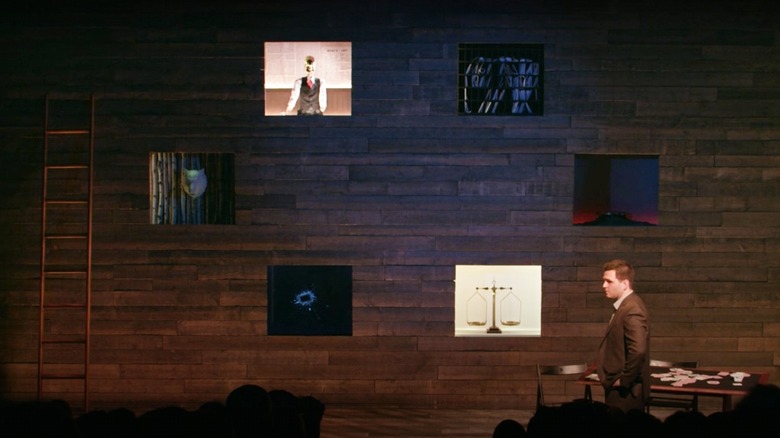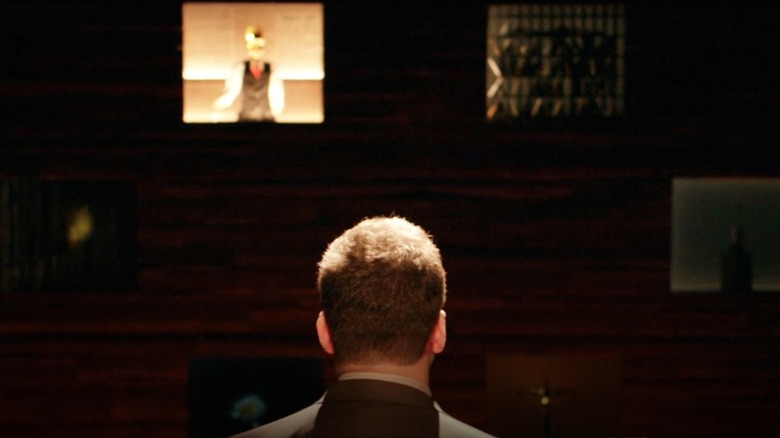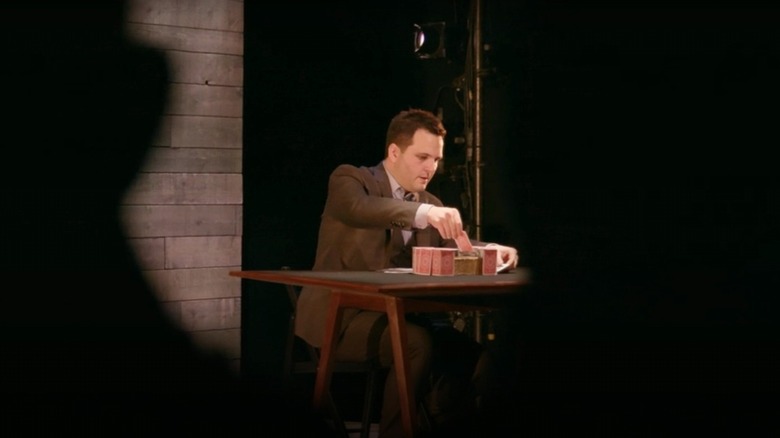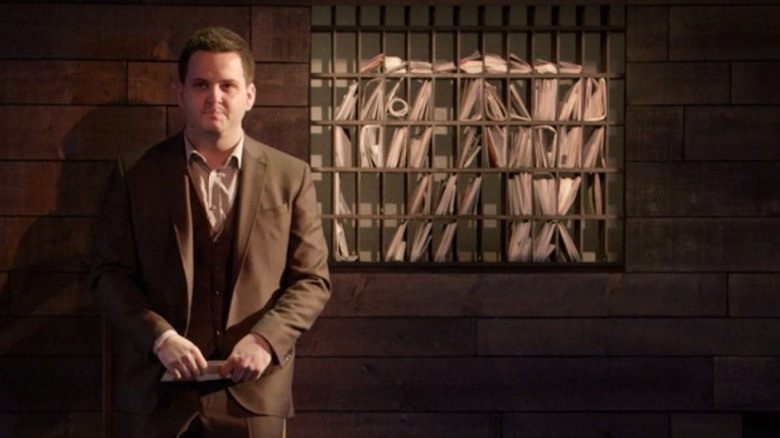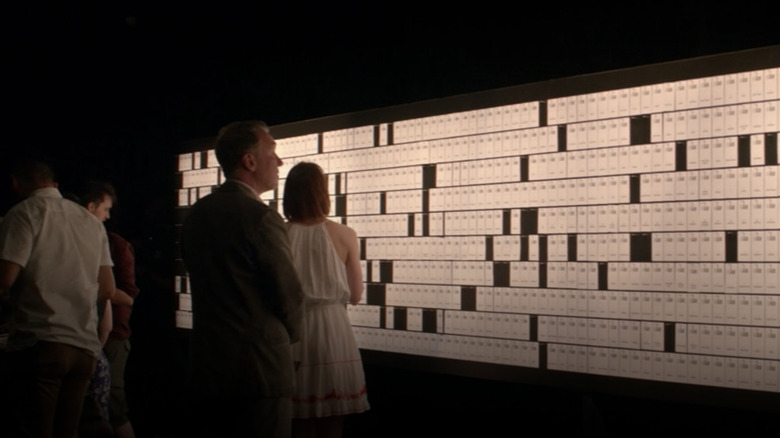The Illusions In Derek DelGaudio's In & Of Itself Explained
As a successful director and a primary puppeteer behind Jim Henson's "The Muppets," Frank Oz's career has spanned almost 60 years. His latest project that came out on Hulu last year. "Derek DelGaudio's In & Of Itself" is a special event documentary that explores illusion mastermind Derek DelGaudio being filmed in front of an audience. Oz also directed the live show "In & Of Itself" that DelGaudio performed for two-and-a-half years in New York and Los Angeles. DelGaudio joins the list of other famous magicians such as David Blaine, Criss Angel, Penn & Teller, and Michael Carbonaro, but his unique and meaningful illusions are unlike any of the others' work.
DelGaudio doesn't call himself a magician. He certainly separates himself from other illusionists by putting on a multi-faceted and emotional interactive experience that will make its viewers ponder the nature of who they are and how others perceive them. According to Bustle, DelGaudio's show is "part magic act, part one-man monologue, part performance art, part audience interaction theater experience." The entirety of "Derek DelGaudio's In & Of Itself" is an exercise in shattering illusions about self, not just for DelGaudio, but also the individuals in the audience.
DelGaudio's show features six immersive vignettes
One of the most intriguing aspects of the documentary is how creatively DelGaudio sets up the show. The whole performance takes place on a theater stage in front of a wall with six different boxed dioramas spaced out. Each appears to be implanted into the wall with lights implemented into the boxes, and each one has a story to tell that correlates to the vignettes DelGaudio describes aloud. He jumps from narrative to narrative about his early childhood and life, and how he became fascinated with card tricks at an early age.
Each of the unbelievable illusions (or "tricks") is interwoven into DelGaudio's search for his own identity and what the illusion of identity means. In an interview with Indiewire, DelGaudio said making the film was "really an act of faith, in line with the work itself. It really is about taking that leap of faith and believing in something you can't know." The six illusions involve a mechanical Roulettista, a paper sailboat in a bottle of whiskey, deceiving card tricks, the true meaning behind a gold brick, a gold scale, cubbies full of letters, and the audience's paper "I am" statements which they had chosen at the beginning of the show.
The Roulettista and the whiskey sailboat
The first vignette involves a tale about a man named the Roulettista. The Roulettista gambled his life away every night using a filled revolver, where he would add up to 6 bullets and pull the trigger each time, with people betting on every bullet. The game became a bet on seeing whether the Roulettista would live or not. He ended up surviving and became extremely wealthy, even getting married, having kids, and living in a giant mansion. One night, a burglar tried to open his safe and the Roulettista caught him and asked: "Do you know who I am?" The burglar replied "No" and shot him. DelGaudio says that this story was reiterated to him by a stranger at a bar, who said that DelGaudio was the Roulettista. If DelGaudio really is the Roulettista, "Was DelGaudio an alcoholic, risking his life with booze? Does it matter?" (via Variety).
The next trick involves a bottle of whiskey. DelGaudio takes the half-full bottle from one of the staged dioramas on the wall, which appears to be placed on a solid surface of some sort. He carefully peels off the label and the audience watches him fold it into a little paper sailboat. He places the sailboat on the top of a chair's backrest without it falling off, and he proceeds to take the bottle and seamlessly slides the sailboat into the bottle. As if that wasn't a shock already, he goes back to the box and runs his hand over that seemingly "solid" surface, but it disintegrates into sand.
A deceiving card trick and a disappearing gold brick
DelGaudio spent years as a bust-out poker dealer (per The New Yorker), meaning that he skillfully cheated people out of winning money. He describes the illusion of how moonlight can make a dog look like a wolf and vice versa. In the second diorama, the head of a wolf has a card in its mouth, which DelGaudio uses to segue into his story about how he developed a passion for card variations, tricks, and maneuvers. He mentions how he mastered sleight of hand and that "he fell in love with all of the things he could not see." His primary set of deceiving card tricks involves "magically" pulling the same exact suits and pips (symbols) for every single card after shuffling them multiple times. He had to morph into a wolf in order to successfully carry out his deception with cards.
In the following segment, DelGaudio confesses to the audience a heartbreaking story about living with his mother. Somebody even threw a brick into their kitchen window and left a Bible on their front doorstep. When people found out his mother was gay, they moved. He pulls out the gold brick that has been strategically placed in a cracked glass window, places it on a table, and builds a house of cards around it. He doesn't give the brick an identity, explaining that nobody knows where it's been or its story, but there's so much more to it than the meaning its given. He blows the cards down and the brick has vanished.
Cubbies full of letters and a leveled scale
DelGaudio chooses audience members to participate in his next segment of the Hulu movie, in which they read letters that are addressed to him with the return address blacked out. On the back of each envelope are identifiers such as "brother," "father," "sister," "friend," and so on. Little do they know that when they open the letter and read it, it's actually from whichever person in their lives they chose, addressed to them. In complete surprise, the emotional transformation of the people reading these personal letters unfolds in front of DelGaudio and the rest of the audience. Their reactions are to be expected, because this is some special type of "magic" that can't possibly be understood or explained. The result is beyond incredible.
Taking all of the "I am" cards that were collected at the beginning of the show, DelGaudio places all of them on one side of a scale, except one. His "I am" statement is what he has been searching for over the entire course of his show, and, once it balances out with the other cards on the scale, every single one of the boxed dioramas lights up. Time is running out for DelGaudio to choose an answer about who or what he is.
'I am' closing statements
The final segment reveals what the audience did, supposedly before the show began. They were placed in front of a huge board with many variations of the "I am" statements pinned to it and began identifying with the statement they felt best described them (or what they hoped would), and took it off the board. DelGaudio collected all of these statements early in the show with the intention of using them at the end to wrap everything up. Audience members have a card that DelGaudio says "Exists within one's own heart and is seen by another." He asks the audience to stand up and starts to name off the varying "I am" statements. One person after another sits down as DelGaudio proceeds to guess every person's statement correctly. People are crying (some laughing), clearly touched by this magical and moving experience. The biggest question is: Who is Derek DelGaudio?
Perhaps DelGaudio structured his "In & Of Itself" performance to function as his personal catharsis of self-discovery. Teary-eyed, he asserts that he is the Roulettista, but that he is "also a son," "an orphan," "a sailor." He is "more than just one thing" and that he is more than what everybody else sees or doesn't see. Just as the audience thinks the performance is over, DelGaudio puts his finger to his head, and, just as he pulls the figurative trigger, the entire wall of dioramas (just images) behind him drops to the floor. As the audience gasps, the only box left contains the mechanical Roulettista.

